Passively Q-Switched Er-Doped Fiber Laser Based on Bentonite Clay (Al2H2O6Si) Saturable Absorber
Abstract
:1. Introduction
2. Deposition of Bentonite Clay Saturable Absorber (SA)
3. Synthesis and Characterization of Bentonite Clay Nanoparticles
4. Modulation Depth of Bentonite Clay Nanoparticles
5. Experimental Setup of Erbium-Doped Fiber Laser
6. Results and Discussion
7. Conclusions
Author Contributions
Funding
Data Availability Statement
Acknowledgments
Conflicts of Interest
References
- Shi, W.; Fang, Q.; Zhu, X.; Norwood, R.A.; Peyghambarian, N. Fiber lasers and their applications. Appl. Opt. 2014, 53, 6554–6568. [Google Scholar] [CrossRef] [PubMed]
- Cheng, J.; Zhang, L.; Sharafudeen, K.; Qiu, J. A 100 mW-level single-mode switchable dual-wavelength erbium-doped fiber laser. Laser Phys. 2013, 23, 105105. [Google Scholar] [CrossRef]
- Armas-Rivera, I.; Rodriguez-Morales, L.A.; Durán-Sánchez, M.; Avazpour, M.; Carrascosa, A.; Silvestre, E.; Kuzin, E.A.; Andres, M.V.; Ibarra-Escamilla, B. Wide wavelength-tunable passive mode-locked Erbium-doped fiber laser with a SESAM. Opt. Laser Technol. 2021, 134, 106593. [Google Scholar] [CrossRef]
- Subramaniam, T.K. Erbium doped fiber lasers for long distance communication using network of fiber optics. Am. J. Opt. Photonics 2015, 3, 34–37. [Google Scholar] [CrossRef]
- Głuszek, A.; Senna Vieira, F.; Hudzikowski, A.; Wąż, A.; Sotor, J.; Foltynowicz, A.; Soboń, G. Compact mode-locked Er-doped fiber laser for broadband cavity-enhanced spectroscopy. Appl. Phys. B 2020, 126, 137. [Google Scholar] [CrossRef]
- Falconi, M.C.; Loconsole, A.M.; Annunziato, A.; Cozic, S.; Poulain, S.; Prudenzano, F. Design of a Broadband Erbium-doped Fluoroindate Fiber Laser Emitting up to 3.91 µm. J. Light. Technol. 2023, 41, 6065–6072. [Google Scholar] [CrossRef]
- Friebele, E.J.; Baker, C.C.; Sanghera, J.S.; LuValle, M.J.; Logothetis, S. Erbium doped fibers for radiation tolerant, high power space laser communications. In Free-Space Laser Communications XXXII; SPIE: Bellingham, WA, USA, 2020; Volume 11272, pp. 235–244. [Google Scholar]
- Zhang, L.; Wang, F. Stannic oxide saturable absorbers for generating Q-switched erbium-doped fiber lasers. Opt. Fiber Technol. 2023, 80, 103469. [Google Scholar] [CrossRef]
- Ahmad, H.; Soltani, S.; Thambiratnam, K.; Yasin, M.; Tiu, Z.C. Mode-locking in Er-doped fiber laser with reduced graphene oxide on a side-polished fiber as saturable absorber. Opt. Fiber Technol. 2019, 50, 177–182. [Google Scholar] [CrossRef]
- Chernysheva, M.; Al Araimi, M.; Kbashi, H.; Arif, R.; Sergeyev, S.V.; Rozhin, A. Isolator-free switchable uni-and bidirectional hybrid mode-locked erbium-doped fiber laser. Opt. Express 2016, 24, 15721–15729. [Google Scholar] [CrossRef] [PubMed]
- Liu, M.; Liu, W.; Liu, X.; Ouyang, Y.; Hou, H.; Lei, M.; Wei, Z. Yttrium oxide as a Q-switcher for the near-infrared erbium-doped fiber laser. Nanophotonics 2020, 9, 2887–2894. [Google Scholar] [CrossRef]
- Hu, G.; Zhu, L.; Chen, K.; Chen, G.; Wang, Z.; Guo, G. Tunable period-multiplying Q-switched pulse outputs based on birefringence induced multiwavelength tuning in a linear erbium-doped fiber oscillator. Infrared Phys. Technol. 2021, 117, 103821. [Google Scholar] [CrossRef]
- Harun, S.W.; Ismail, M.A.; Ahmad, F.; Ismail, M.F.; Nor, R.M.; Zulkepely, N.R.; Ahmad, H. A Q-switched erbium-doped fiber laser with a carbon nanotube based saturable absorber. Chin. Phys. Lett. 2012, 29, 114202. [Google Scholar] [CrossRef]
- Chang, Y.M.; Lee, J.; Jhon, Y.M.; Lee, J.H. Active Q-switching in an erbium-doped fiber laser using an ultrafast silicon-based variable optical attenuator. Opt. Express 2011, 19, 26911–26916. [Google Scholar] [CrossRef] [PubMed]
- Nissilae, S.M.; Kostamovaara, J.T. Fiber laser as the pulse source for a laser rangefinder system. In Industrial Applications of Optical Inspection, Metrology, and Sensing; SPIE: Bellingham, WA, USA, 1993; Volume 1821, pp. 375–383. [Google Scholar]
- Chandonnet, A.; Larose, G. High-power Q-switched erbium fiber laser using an all-fiber intensity modulator. Opt. Eng. 1993, 32, 2031. [Google Scholar] [CrossRef]
- Keller, U.; Weingarten, K.J.; Kartner, F.X.; Kopf, D.; Braun, B.; Jung, I.D.; Fluck, R.; Honninger, C.; Matuschek, N.; Der Au, J.A. Semiconductor saturable absorber mirrors (SESAM's) for femtosecond to nanosecond pulse generation in solid-state lasers. IEEE J. Sel. Top. Quantum Electron. 1996, 2, 435–453. [Google Scholar] [CrossRef]
- Muhammad, F.D.; Zulkifli, M.Z.; Latif, A.A.; Harun, S.W.; Ahmad, H. Graphene-based saturable absorber for single-longitudinal-mode operation of highly doped erbium-doped fiber laser. IEEE Photonics J. 2012, 4, 467–475. [Google Scholar] [CrossRef]
- Lazdovskaia, U.S.; Orekhov, I.O.; Ismaeel, A.; Feifei, Y.; Dvoretskiy, D.A.; Sazonkin, S.G.; Karasik, V.E.; Denisov, L.K.; Davydov, V.A. High-Density Well-Aligned Single-Walled Carbon Nanotubes for Application as a Saturable Absorber with a High-Pass Filter Effect in an Erbium-Doped Ultra-Short-Pulse Fiber Laser. ACS Appl. Nano Mater. 2023, 6, 23410–23417. [Google Scholar] [CrossRef]
- Hong, Z.; Jiang, X.; Zhang, M.; Zhang, H.; Liu, X. High power and large-energy pulse generation in an erbium-doped fiber laser by a ferromagnetic insulator-Cr2Si2Te6 saturable absorber. Nanomaterials 2022, 12, 564. [Google Scholar] [CrossRef] [PubMed]
- Wei, B.N.; Jiao, Z.H.; Liu, W.J. Ternary transition metal dichalcogenides for passively Q-switched Er-doped fiber laser applications. Optik 2021, 248, 168096. [Google Scholar] [CrossRef]
- Asghar, H.; Ahmed, R.; Ajmal, R.; Umar, Z.A.; McInerney, J.G.; Baig, M.A. Ameliorating the stability of erbium-doped fiber laser using saturable absorber fabricated by the pulsed laser deposition technique. Sci. Rep. 2022, 12, 20267. [Google Scholar] [CrossRef]
- Asghar, H.; Ahmed, R.; Umar, Z.A.; Baig, M.A. A novel technique for the fabrication of a saturable absorber for fiber lasers: Pulsed laser deposition. Laser Phys. Lett. 2022, 19, 075106. [Google Scholar] [CrossRef]
- Alghamdi, T.A.; Adwan, S.; Arof, H.; Harun, S.W. Application of black phosphorus for pulse generation in erbium-doped fiber laser. Results Opt. 2021, 4, 100091. [Google Scholar] [CrossRef]
- Asghar, H.; Ahmed, R.; Sohail, M.; Umar, Z.A.; Baig, M.A. Q-switched pulse operation in erbium-doped fiber laser subject to CdS nanoparticles-based saturable absorber deposit directly on the fiber ferrule. Opt. Mater. 2022, 134, 113109. [Google Scholar] [CrossRef]
- Vipulanandan, C.; Mohammed, A. Effect of nanoclay on the electrical resistivity and rheological properties of smart and sensing bentonite drilling muds. J. Pet. Sci. Eng. 2015, 130, 86–95. [Google Scholar] [CrossRef]
- Bhat, G.; Hegde, R.R.; Kamath, M.G.; Deshpande, B. Nanoclay reinforced fibers and nonwovens. J. Eng. Fibers Fabr. 2008, 3, 155892500800300303. [Google Scholar] [CrossRef]
- Muhammad, F.D.; Chyi, J.L.Y.; Mohd Asran, A.N.; Alresheedi, M.T.; Ng, E.K.; Mahdi, M.A. Fe2O3 Nanoparticle-Based Q-Switched Pulse Fiber Laser. Photonics 2023, 10, 995. [Google Scholar] [CrossRef]
- Yusoff, R.A.M.; Jafry, A.A.A.; Kasim, N.; Zulkipli, N.F.; Samsamnun, F.S.M.; Yasin, M.; Harun, S.W. Q-switched and mode-locked erbium-doped fiber laser using gadolinium oxide as saturable absorber. Opt. Fiber Technol. 2020, 57, 102209. [Google Scholar] [CrossRef]
- Johari, A.R.; Krishnan, G.; Bakhtiar, H.; Sapingi, H.H.J. Pulsed Laser Performance of Erbium Doped Fiber Laser Using Titanium Dioxide Nanoparticles as Saturable Absorber. J. Phys. Conf. Ser. 2021, 1892, 012013. [Google Scholar] [CrossRef]
- Nizamani, B.; Memon, F.A.; Umar, Z.A.; Salam, S.; Najm, M.M.; Khudus, M.A.; Hanafi, E.; Baig, M.A.; Harun, S.W. Q-switched erbium-doped fiber laser with silicon oxycarbide saturable absorber. Optik 2020, 219, 165234. [Google Scholar] [CrossRef]
- Al-Hayali, S.K.M.; Mohammed, D.Z.; Khaleel, W.A.; Al-Janabi, A.H. Aluminum oxide nanoparticles as saturable absorber for C-band passively Q-switched fiber laser. Appl. Opt. 2017, 56, 4720–4726. [Google Scholar] [CrossRef] [PubMed]
- Salman, A.A.; Al-Janabi, A.H. Aluminum nanoparticles saturable absorber as a passive Q-switcher for erbium-doped fiber laser ring cavity configuration. Laser Phys. 2019, 29, 045102. [Google Scholar] [CrossRef]
- Liu, G.; Lyu, Y.; Li, Z.; Wu, T.; Yuan, J.; Yue, X.; Zhang, H.; Zhang, F.; Fu, S. Q-switched erbium-doped fiber laser based on silicon nanosheets as saturable absorber. Optik 2020, 202, 163692. [Google Scholar] [CrossRef]
- Nizamani, B.; Jafry, A.A.A.; Salam, S.; Fizza, G.; Soboh, R.S.M.; Khudus, M.A.; Hanafi, E.; Yasin, M.; Harun, S.W. Aluminium zinc oxide as a saturable absorber for passively Q-switched and mode-locked erbium-doped fiber laser. Laser Phys. 2021, 31, 055101. [Google Scholar] [CrossRef]

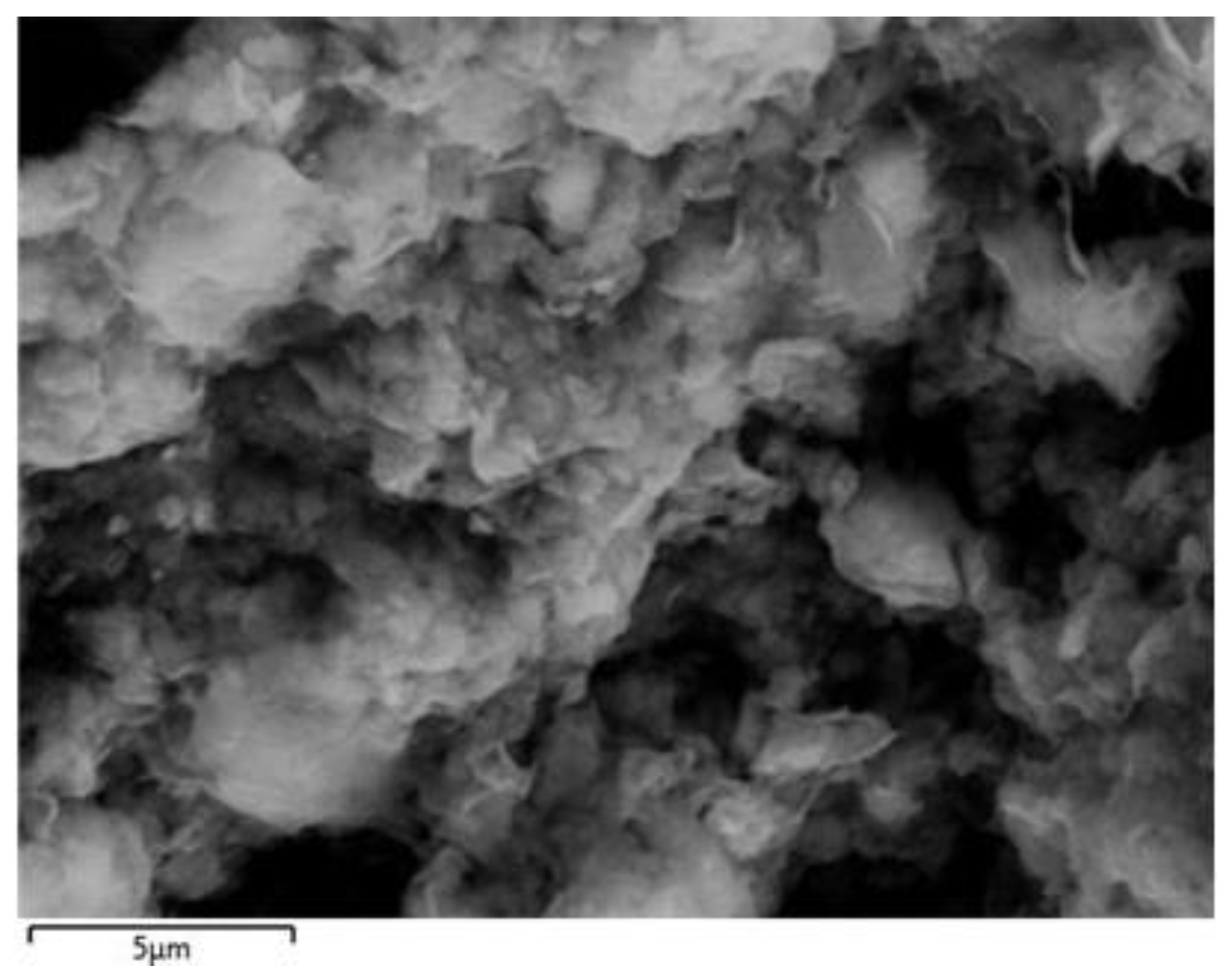
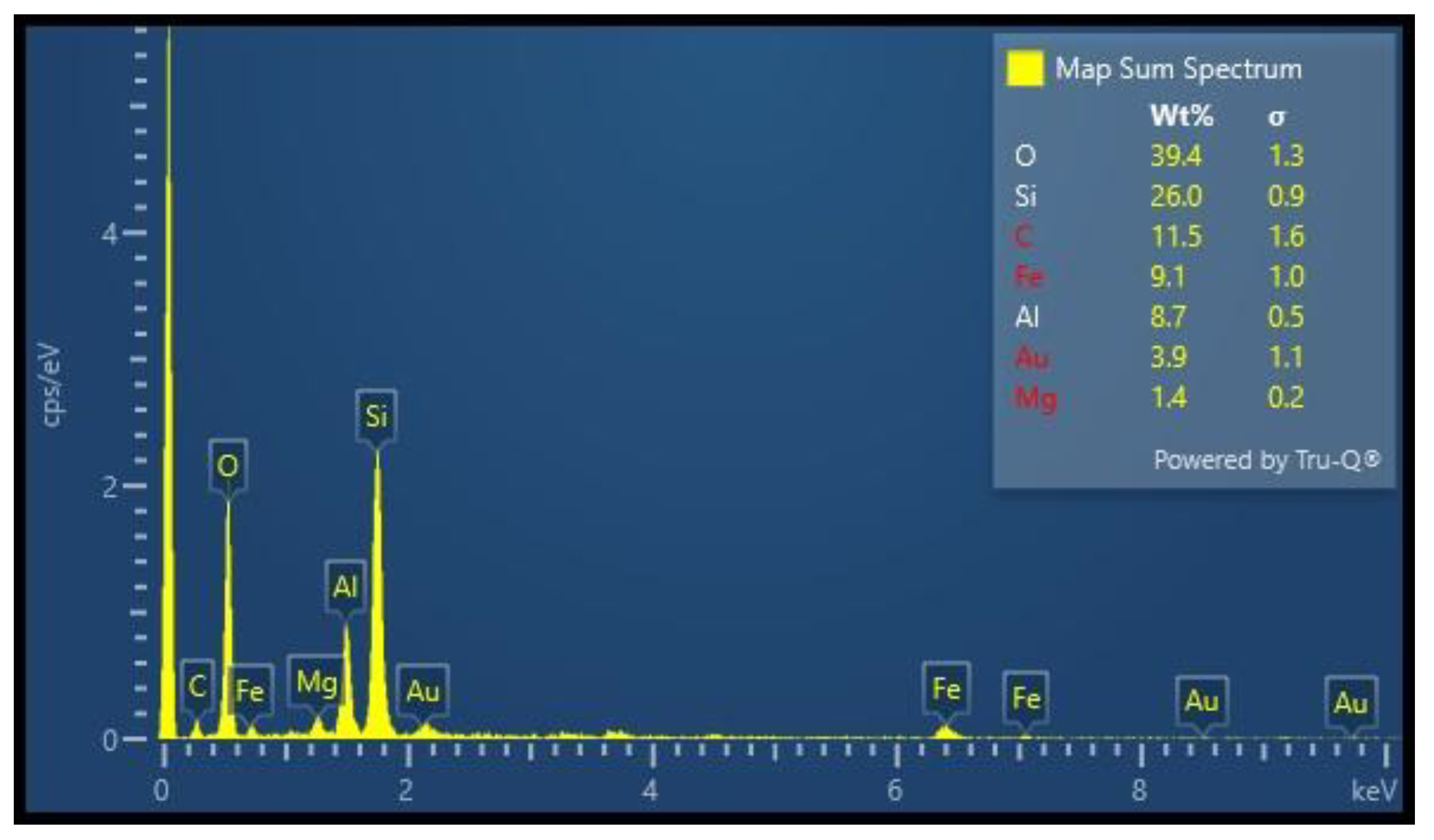
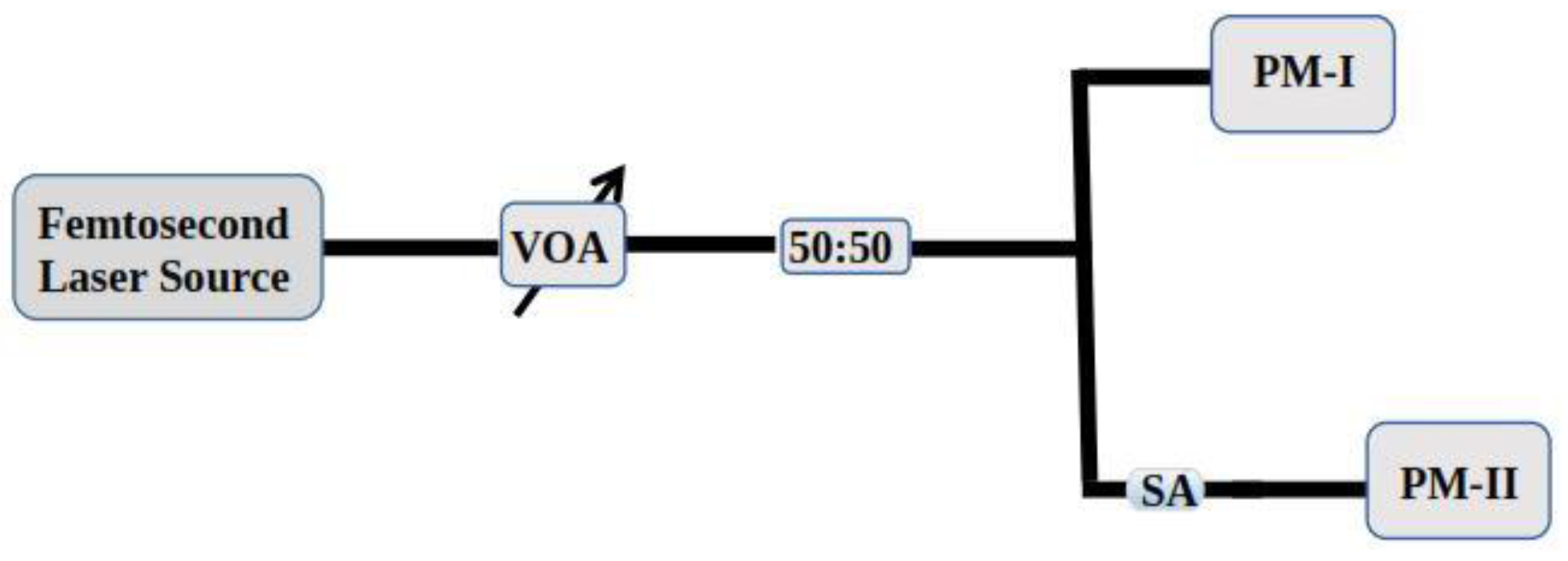

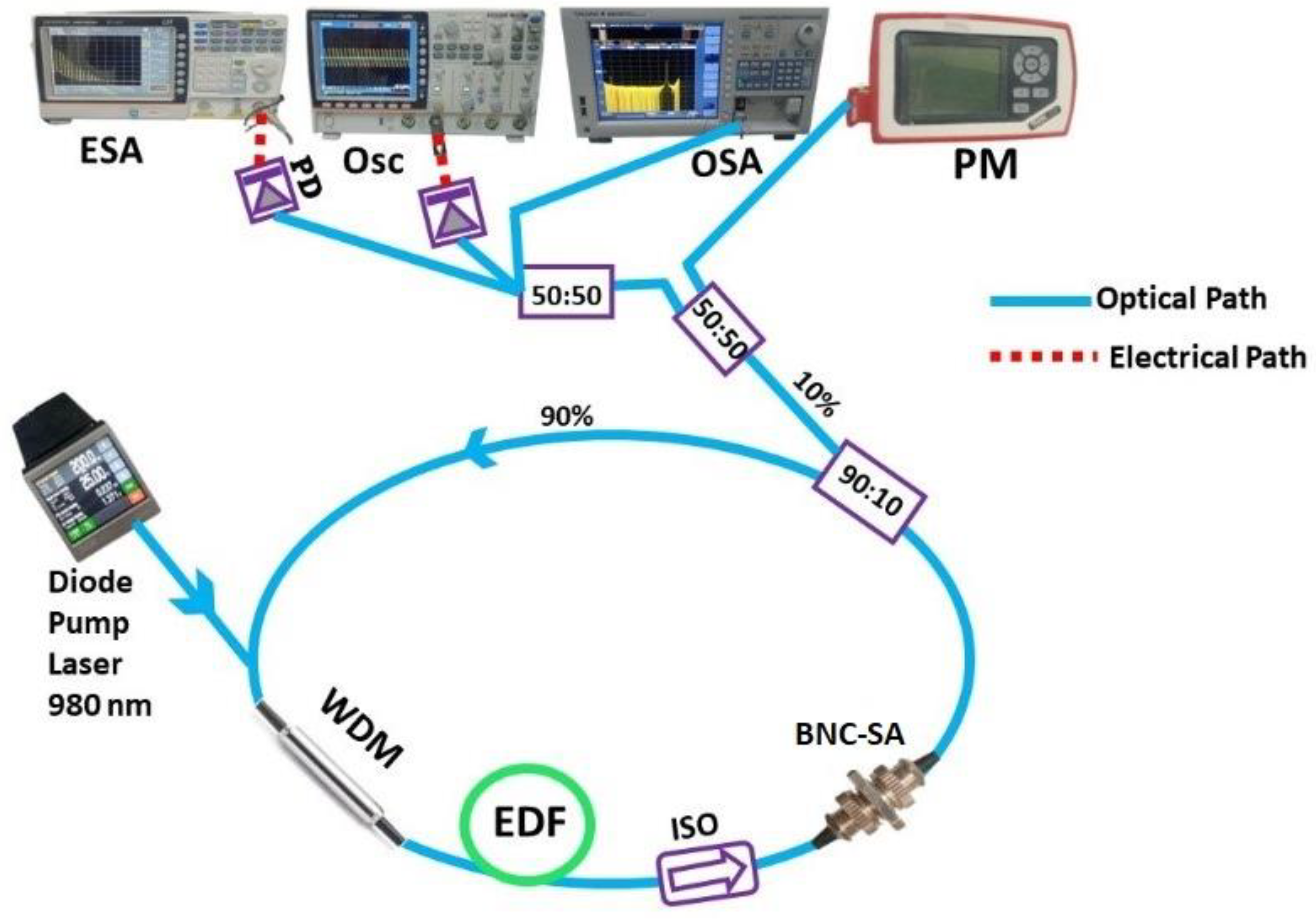
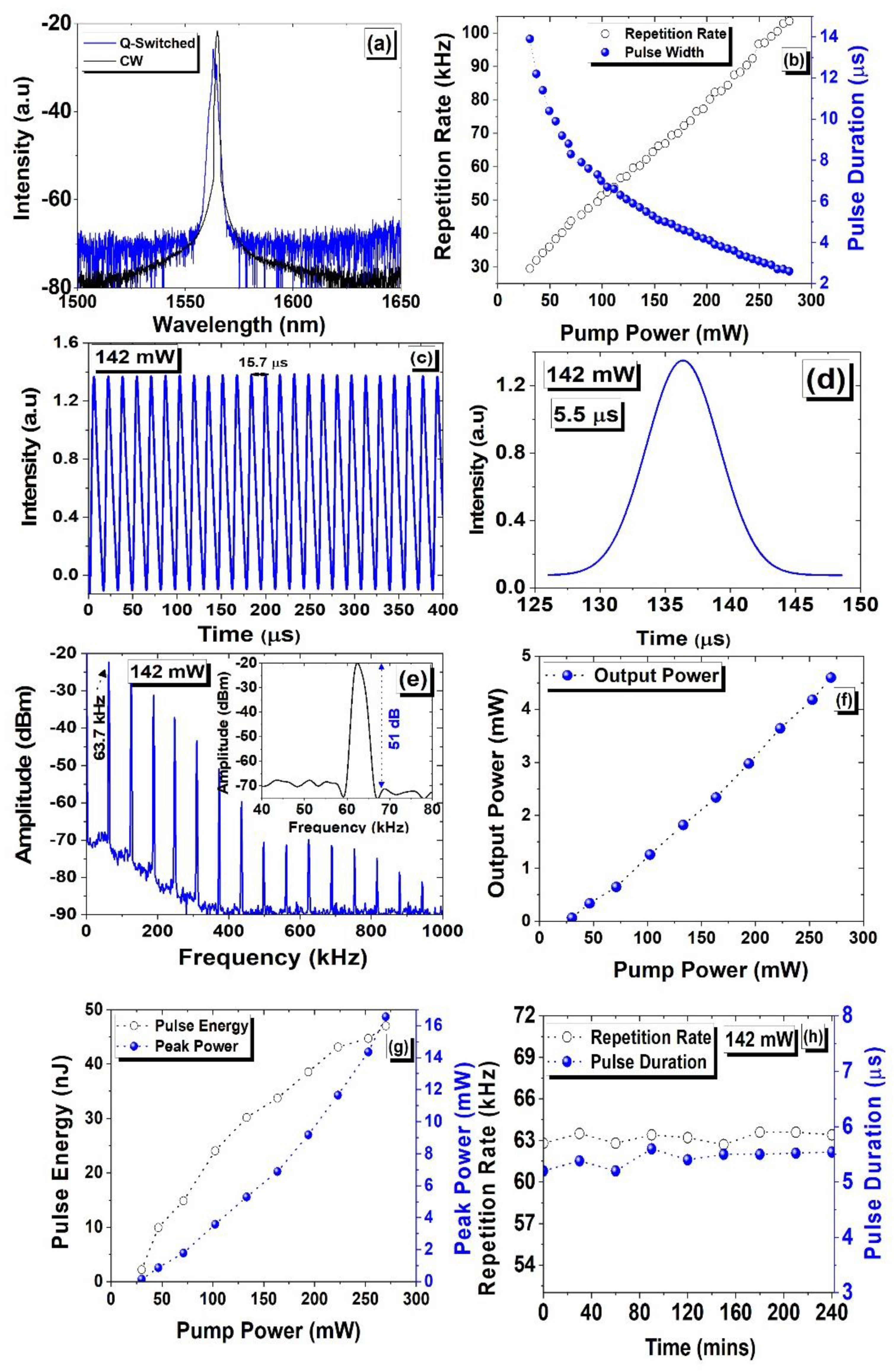
| SA-Material | Integration Method | Pulse Duration (μs) | Repetition Rates (kHz) | Peak Power (mW) | Average Power (mW) | Pulse Energy (nJ) | Q-Switching Threshold- (mW) | Q-Switching Range (mW) | SNR (dB) | Ref |
|---|---|---|---|---|---|---|---|---|---|---|
| SiOC | PVA-Film | 2.1 | 96.7 | - | 2.4 | 25 | 111.1 | 111.1–198 | 70 | [31] |
| Al2O3 | Nanoparticles | 2.8 | 81 | - | - | 56.7 | 158 | 158–330 | 56 | [32] |
| Al | Nanoparticles | 2.17 | 48.8 | - | 0.55 | 11.29 | 156 | 156–300 | 45 | [33] |
| Si | PVA-Film | 2.32 | 58.7 | 6.3 | 0.89 | - | 41.5 | 41.5–164 | - | [34] |
| Aluminium zinc oxide | PVA-Film | 2.2 | 86 | 21.5 | 4.1 | 47.3 | 45.3 | 45.3–198 | 69 | [35] |
| Al2H2O6Si | Nanoparticles | 2.6 | 103.6 | 16.56 | 4.6 | 47 | 30.8 | 30.8–278.96 | 51 | This work |
Disclaimer/Publisher’s Note: The statements, opinions and data contained in all publications are solely those of the individual author(s) and contributor(s) and not of MDPI and/or the editor(s). MDPI and/or the editor(s) disclaim responsibility for any injury to people or property resulting from any ideas, methods, instructions or products referred to in the content. |
© 2024 by the authors. Licensee MDPI, Basel, Switzerland. This article is an open access article distributed under the terms and conditions of the Creative Commons Attribution (CC BY) license (https://creativecommons.org/licenses/by/4.0/).
Share and Cite
Asghar, H.; Khalid, U.S.; Sohail, M.; Alrebdi, T.A.; Umar, Z.A.; Alshehri, A.M.; Ahmed, R.; Baig, M.A. Passively Q-Switched Er-Doped Fiber Laser Based on Bentonite Clay (Al2H2O6Si) Saturable Absorber. Micromachines 2024, 15, 267. https://doi.org/10.3390/mi15020267
Asghar H, Khalid US, Sohail M, Alrebdi TA, Umar ZA, Alshehri AM, Ahmed R, Baig MA. Passively Q-Switched Er-Doped Fiber Laser Based on Bentonite Clay (Al2H2O6Si) Saturable Absorber. Micromachines. 2024; 15(2):267. https://doi.org/10.3390/mi15020267
Chicago/Turabian StyleAsghar, Haroon, Umer Sayyab Khalid, Muhammad Sohail, Tahani A. Alrebdi, Zeshan A. Umar, A. M. Alshehri, Rizwan Ahmed, and M. Aslam Baig. 2024. "Passively Q-Switched Er-Doped Fiber Laser Based on Bentonite Clay (Al2H2O6Si) Saturable Absorber" Micromachines 15, no. 2: 267. https://doi.org/10.3390/mi15020267






